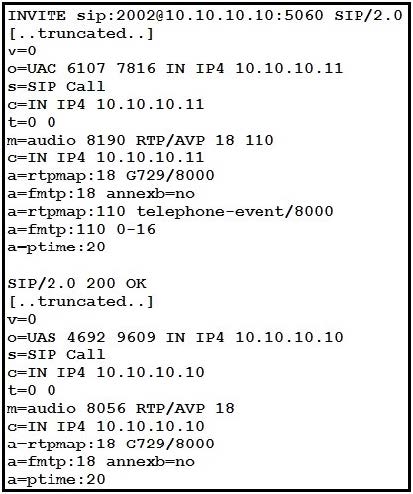Exam Details
Exam Code
:350-801Exam Name
:Implementing and Operating Cisco Collaboration Core Technologies (CLCOR)Certification
:CCNP CollaborationVendor
:CiscoTotal Questions
:500 Q&AsLast Updated
:Apr 16, 2025
Cisco CCNP Collaboration 350-801 Questions & Answers
-
Question 371:
Refer to the exhibit.

Given this "debug isdn q921" output, what is the problem with the PRI?
A. Layer 1 is down on the controller.
B. PRI does not have an IP address configured on the interface.
C. Nothing, the PRI is sending keepalives.
D. Layer 2 is down on the controller.
-
Question 372:
A collaboration engineer must configure Cisco Unified Border Element to support up to five concurrent outbound calls across an Ethernet link with a bandwidth of 160 kb to the Internet Telephony Service Provider.
Which set of commands allows the engineer to complete the task without compromising voice quality?
A. dial-peer voice 1 voip translation-profile outgoing Strip9 max-conn 5 destination-pattern 91[2-9]..[2-9]......$ session protocol sipv2 session target ipv4:142.45.10.1 dtmf-relay rtp-nte sip-notify sip-kpml
B. dial-peer voice 1 voip translation-profile outgoing Strip9 max-conn 5 destination-pattern 91[2-9]..[2-9]......$ session protocol sipv2 session target ipv4:142.45.10.1 dtmf-relay rtp-nte sip-notify sip-kpml codec ilbc mode 20
C. dial-peer voice 1 voip translation-profile outgoing Strip9 max-conn 5 destination-pattern 91[2-9]..[2-9]......$ session protocol sipv2 session target ipv4:142.45.10.1 dtmf-relay rtp-nte sip-notify sip-kpml codec aacld
D. dial-peer voice 1 voip translation-profile outgoing Strip9 max-conn 5 destination-pattern 91[2-9]..[2-9]......$ session protocol sipv2 session target ipv4:142.45.10.1 dtmf-relay rtp-nte sip-notify sip-kpml codec mp4a-latm
-
Question 373:
An engineer is configuring a BOT device for a Jabber user in Cisco Unified Communication Manager Which phone type must be selected?
A. third-party SIP device
B. Cisco Dual Mode for iPhone
C. Cisco Dual Mode for Android
D. Cisco Unified Client Services Framework
-
Question 374:
What is the major difference between the two possible Cisco IM and Presence high-availability modes?
A. Balanced mode provides user load balancing and user failover in the event of an outage. Active/standby mode provides an always on standby node in the event of an outage, and it also provides load balancing.
B. Balanced mode provides user load balancing and user failover only for manually generated failovers. Active/standby mode provides an unconfigured standby node in the event of an outage, but it does not provide load balancing.
C. Balanced mode provides user load balancing and user failover in the event of an outage. Active/standby mode provides an always on standby node in the event of an outage, but it does not provide load balancing.
D. Balanced mode does not provide user load balancing, but it provides in the event of an outage. Active/standby mode provides an always on standby node in the event of an outage, but it does not provide load balancing.
-
Question 375:
A remote office has a less-than-optimal WAN connection and experiences packet loss, delay, and jitter. Which VoIP codec should be used in this situation?
A. G.711ulaw
B. iLBC
C. G.722.1
D. G.729A
-
Question 376:
Which two functionalities does Cisco Expressway provide in the Cisco Collaboration architecture? (Choose two.)
A. Survivable Remote Site Telephony functionality
B. customer interaction management services
C. secure firewall and NAT traversal for mobile or remote Cisco Jabber and TelePresence Video endpoints
D. MGCP gateway registration
E. Secure business-to-business communications
-
Question 377:
Which two types of device are supported by the Bulk Administration Tool? (Choose two.)
A. H.322 clients
B. Cisco Unified IP phones (all models)
C. SIP trunks
D. H.225 trunks
E. music on hold servers
-
Question 378:
How are E164 called-party numbers normalized on a globalized call-routing environment in Cisco Unified Communications Manager?
A. Normalization is achieved by stripping or translating the called numbers to internally used directory numbers.
B. Normalization is achieved by setting up calling search spaces and partitions at the SIP trunks for PSTN connection.
C. Call ingress must be normalized before the call being routed.
D. Normalization is not required.
-
Question 379:
An engineer configures local route group to simplify a dial plan. Where does the engineer set the route groups according to the local route group names that are configured?
A. CSS
B. route pattern
C. device pool
D. route list
-
Question 380:
Refer to the exhibit

The SDP offer/answer has been completed successfully but there is no DTMF when users press keys. What is the cause of the issue?
A. DTMF was negotiated properly in these messages.
B. G.729 rather than G.711ulaw was negotiated.
C. Payload type 110 was negotiated rather than type 101.
D. DTMF was not negotiated on the call.
Related Exams:
300-810
Implementing Cisco Collaboration Applications (CLICA)300-815
Implementing Cisco Advanced Call Control and Mobility Services (CLACCM)300-820
Implementing Cisco Collaboration Cloud and Edge Solutions (CLCEI)300-835
Automating Cisco Collaboration Solutions (CLAUTO)350-801
Implementing and Operating Cisco Collaboration Core Technologies (CLCOR)
Tips on How to Prepare for the Exams
Nowadays, the certification exams become more and more important and required by more and more enterprises when applying for a job. But how to prepare for the exam effectively? How to prepare for the exam in a short time with less efforts? How to get a ideal result and how to find the most reliable resources? Here on Vcedump.com, you will find all the answers. Vcedump.com provide not only Cisco exam questions, answers and explanations but also complete assistance on your exam preparation and certification application. If you are confused on your 350-801 exam preparations and Cisco certification application, do not hesitate to visit our Vcedump.com to find your solutions here.